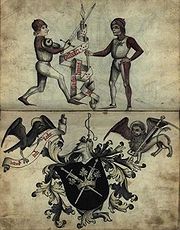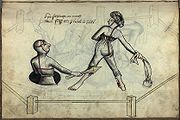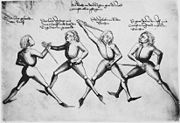
Hans Talhoffer
Encyclopedia




Fechtbuch
Martial arts manuals are instructions, with or without illustrations, detailing specific techniques of martial arts.Prose descriptions of martial arts techniques appear late within the history of literature, due to the inherent difficulties of describing a technique rather than just demonstrating...
, illustrated treatises describing methods of fighting with bare hands
Grappling
Grappling refers to techniques, maneuvers, and counters applied to an opponent in order to gain a physical advantage, such as improving relative position, escaping, submitting, or injury to the opponent. Grappling is a general term that covers techniques used in many disciplines, styles and martial...
, dagger
Dagger
A dagger is a fighting knife with a sharp point designed or capable of being used as a thrusting or stabbing weapon. The design dates to human prehistory, and daggers have been used throughout human experience to the modern day in close combat confrontations...
, long sword, short sword, pole weapon
Pole weapon
A pole weapon or polearm is a close combat weapon in which the main fighting part of the weapon is placed on the end of a long shaft, typically of wood, thereby extending the user's effective range. Spears, glaives, poleaxes, halberds, and bardiches are all varieties of polearms...
s, shields
Shield
A shield is a type of personal armor, meant to intercept attacks, either by stopping projectiles such as arrows or redirecting a hit from a sword, mace or battle axe to the side of the shield-bearer....
, maces, and on horseback.
Overview
Talhoffer was a contemporary of fencing master Paulus KalPaulus Kal
Paulus Kal was a 15th century German fencing master. In 1460, he wrote a combat manual describing the art of fencing .-Literature:...
, an exponent of the German school of fencing
German school of fencing
The German school of fencing is the historical system of combat taught in the Holy Roman Empire in the Late Medieval, Renaissance and Early Modern periods , as described in the Fechtbücher written at the time...
, and 'probably a follower of the Grand Fechtmeister Hans Liechtenauer.'
One of the few pieces of documentary evidence about Talhoffer's life appears in the records of Zürich
Zürich
Zurich is the largest city in Switzerland and the capital of the canton of Zurich. It is located in central Switzerland at the northwestern tip of Lake Zurich...
(Switzerland), documenting that he was teaching near the Rathaus (city hall) in 1454, where a fight broke out among his students, resulting in various fines.
John Clements, Director of the Historical Armed Combat Association
Association for Renaissance Martial Arts
Association for Renaissance Martial Arts is an international educational non-profit organization dedicated to the study and practice of historical European martial arts of the 15th to 17th centuries...
proposed in a foreword to a 2000 edition of the 1467 Talhoffer Fechtbuch that modern use of the term 'martial arts' is incorrectly associated primarily with Asian practices, and that Talhoffer's work exemplified 'hundreds' of similar fighting manuals in Medieval Europe that 'present to us a portrait of highly developed and innovative European martial arts based on sophisticated, systematic and effective skills.'
Mark Rector notes in his introduction to his 2000 translation of the 1467 Talhoffer Fechtbuch that medieval swords were quite light, weighing between two and four pounds (roughly one to two kg) and were well balanced. Medieval European martial arts used nimble footwork and a 'primary tactical principle' of 'single time' so that 'every attack contains a defence and every defence contains a counter-attack'.
Techniques illustrated by Talhoffer include unusual handling of swords, such as half-swording (gripping a hand-and-a-half or two-handed sword with one hand near the pommel and the other on the forte
Forte (fencing)
In fencing, forte is "the strong part" of the blade — the one third closest to the hilt. The "strength" refers to the control established over the opponent's weapon upon contact of one's forte with the opponent's foible...
of the blade), handling swords at the tip to use the guard as a bludgeon or hook, and the use of cello-shaped shields that featured spiked ends for hooking and impaling opponents. Illustrations depicting a judicial duel between a man and a woman suggest duelling was not the sole preserve of men.
Works
Talhoffer's work is among the most widely known of the 15th century German Fechtmeister. There are six surviving illustrated Fechtbücher, documenting a span of three decades of his activity.A list of the Fechtbücher by Hans Talhoffer:
- (1) MS Chart. A 558, GothaGotha (town)Gotha is a town in Thuringia, within the central core of Germany. It is the capital of the district of Gotha.- History :The town has existed at least since the 8th century, when it was mentioned in a document signed by Charlemagne as Villa Gotaha . Its importance derives from having been chosen in...
, 151 folia, 178 drawings, 41 pages of text, 1443. - (2) HS XIX. 17-3, Königsegg, 73 folia, ca. 1450.
- (3) P 5342 B (Cod. Nr. 55 Ambras). Copy of (2)
- (4) 78 A 15, BerlinBerlinBerlin is the capital city of Germany and is one of the 16 states of Germany. With a population of 3.45 million people, Berlin is Germany's largest city. It is the second most populous city proper and the seventh most populous urban area in the European Union...
, 77 folia., before 1459. - (5) Thott 290 2, Kongelige Bibliothek, CopenhagenCopenhagenCopenhagen is the capital and largest city of Denmark, with an urban population of 1,199,224 and a metropolitan population of 1,930,260 . With the completion of the transnational Øresund Bridge in 2000, Copenhagen has become the centre of the increasingly integrating Øresund Region...
, Hans Talhoffers Alte Armatur und Ringkunst, 150 folia, 1459 - (6) Cod. icon. 394, 137 folia, 1467.
- (7) Cod. Vindob. Ser. Nov. 2978 276 folia, 16th century copy of (6).
Of these, (1), (3) and (6) have been edited by Gustav Hergsell. (5) is available online as full facsimile at the website of the Kongelige Bibliotek.
So that ignoring copies, (4) is the only known manuscript that remains unpublished as of 2006. The Association for Renaissance Martial Arts
Association for Renaissance Martial Arts
Association for Renaissance Martial Arts is an international educational non-profit organization dedicated to the study and practice of historical European martial arts of the 15th to 17th centuries...
website also has a complete English translation and analysis of the 1459 Thott Manuscript(5) by Jeffrey Hull.
See also
- German school of swordsmanshipGerman school of swordsmanshipThe German school of fencing is the historical system of combat taught in the Holy Roman Empire in the Late Medieval, Renaissance and Early Modern periods , as described in the Fechtbücher written at the time...
- Historical European Martial ArtsHistorical European martial artsHistorical European martial arts is a neologism describing martial arts of European origin, used particularly to refer to arts formerly practised, but having since died out or evolved into very different forms...
- Martial arts manual
External links
- Fight Earnestly – the Fight-Book from 1459 AD by Hans Talhoffer by Jeffrey Hull
- Dagger Techniques From Hans Talhoffer by Eli Steenput
- Hans Thalhofer: Alte Armatur und Ringkunst at the Royal Danish Library

